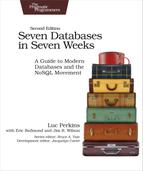Wrap-Up
We hope this taste of MongoDB has piqued your fancy and showed you how it earns the moniker of the “humongous” database. We covered a lot in a single chapter, but as usual, we only clawed at the surface.
Mongo’s Strengths
Mongo’s primary strength lies in its ability to handle huge amounts of data (and huge amounts of requests) by replication and horizontal scaling. But it also has an added benefit of a very flexible data model. You don’t ever need to conform to a schema and can simply nest any values you would generally join using SQL in an RDBMS.
Finally, MongoDB was built to be easy to use. You may have noticed the similarity between Mongo commands and SQL database concepts (minus the server-side joins). This is not by accident and is one reason Mongo has so much mind share amongst people who have defected from the relational database camp. It’s different enough to scratch a lot of developer itches but not so different that it becomes a weird and scary monster.
Mongo’s Weaknesses
Mongo encourages denormalization of schemas (by not having any) and that can be a bit too much for some to swallow. Some developers find the cold, hard constraints of a relational database reassuring. It can be dangerous to insert any old value of any type into any collection. A single typo can cause hours of headache if you don’t think to look at field names and collection names as a possible culprit. Mongo’s flexibility is generally not important if your data model is already fairly mature and locked down.
Because Mongo is focused on large datasets, it works best in large clusters, which can require some effort to design and manage. Unlike some clustered databases where adding new nodes is a transparent and relatively painless process, setting up a Mongo cluster requires a little more forethought.
Parting Thoughts
Mongo is an excellent choice if you are currently using a relational database to store your data using ORM-style patterns. We often recommend it to developers steeped in frameworks such as Ruby on Rails and Django because they can then perform validations and field management through the models at the application layer and because schema migrations become a thing of the past (for the most part). Adding new fields to a document is as easy as adding a new field to your data model, and Mongo will happily accept the new terms. We find Mongo to be a much more natural answer to many common problem scopes for application-driven datasets than relational databases.
